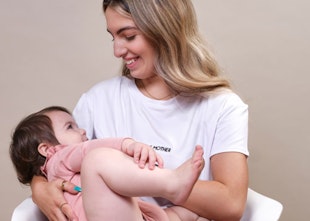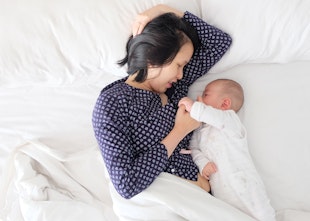Babies are curious little creatures once they become mobile and in their eyes, your home is just one big playground. Here's how to really baby proof your home.
The key to baby-proofing your home is seeing things from your child's point of view so we always recommend you sit or crawl along the floor and see it from their world.
If you're in the midst of the toddler chaos, here are some ways to really baby proof your home, room for room.
- If you have horizontal blinds with cords in your home, either cut the cord (as they provide a severe strangulation risk) or insert a safety device that will secure the loop to the wall.
- Strap all large pieces of furniture such as bookshelves, TV's and dressers to the wall so that if children climb them, they won't fall over and cause injury.
- It is essential to insert safety gates at the bottom and top of your stairs to keep your child from trying to climb up somewhere they are not supposed to and avoid potentially hurting themselves in the process.
- Do not use cot bumpers or any decorative cutouts in your child's crib that a baby could potentially get caught up in. Cot mobiles should be at least 7 inches above the crib.
- When baby proofing your home, ensure your child's crib is placed safely away from any windows, vents or radiators, and make sure they cannot reach lamps or anything that poses a risk from any corner of their crib.
- If there are any loose wires in your child's bedroom, conceal them in a wire guard.
Do not use cot bumpers or any decorative cutouts in your child's crib that a baby could potentially get caught up in.
- Keep your medicine box and other hazardous products such as cleaning products securely locked away up high and out of the reach of children especially all types of washing tablets, pods and capsules.
- Place childproof locks or guards on all windows, doors, and cabinets in your home.
- Insert foam door stoppers on all doors to keep little fingers from getting pinched or crushed.
- Keep pet food out of reach. Hard animal biscuits are a potential choking hazard to small children.
- Plastic bags and cling film can suffocate a child so be sure to store them securely out of reach.
- Store glassware, ornaments, sharp knives and other sharp tools such as peels, graters and food-processor blades in latched drawers or high cabinets.
- Avoid placing coins, batteries, balloons and even whole grapes on low surfaces - they pose a high choking hazard.
- If you use a gas cooker, see if you can remove the dials when you're not cooking and place childproof covers or a stove guard to help prevent little hands from touching piping hot surfaces.
- Do not keep a cloth on a dining table, if your toddler pulls at it, it is possible for them to pull it down along with everything on it on top of themselves.

- When a baby is in his/her highchair make sure to use the five-point harness at all times and never leave them unattended.
- Install corner protectors and edge bumpers to furniture with sharp edges around your home especially in places your child may fall and bump their head.
- Install non-slip pads under all rugs and place a rubber mat in your bath to help prevent falls.
- You might not think it, but toilets can be dangerous in so many ways. Avoid potential drowning with a toilet seat lock and of course to keep pesky little fingers away.
- For the same reasons, it is important to remove drain plugs when they are not in use and never leave a child unattended in the bath - not even for a second.
- Unused electrical outlets should be covered or hidden from view at all times so tiny tots don't attempt to stick their fingers in and get shocked.
Other things you need to consider:
- Make sure the medicine cabinet and first-aid kits are fully stocked with all the basic essentials to deal with temperatures, minor burns and falls.
- It may be time to consider blocking access to radiators and floor heaters when your baby becomes mobile to avoid any unnecessary burns.
- Remove poisonous plants. Do your research and make sure none of your pretty plants is toxic to young children. Cactus are a potential hazard to little ones so best to keep them up high and out of reach.
- Create an emergency contact list and keep it visible at all times in your house. It should have the public poison's number listed, your GP, local hospital and other numbers you may need in the case of an emergency.
- It is extremely important to never leave any children (no matter their age) alone with a pet, no matter how loved your pet may be.
- And finally, install a smoke alarm, carbon monoxide alarm and create a fire safety plan in the event of a fire.







